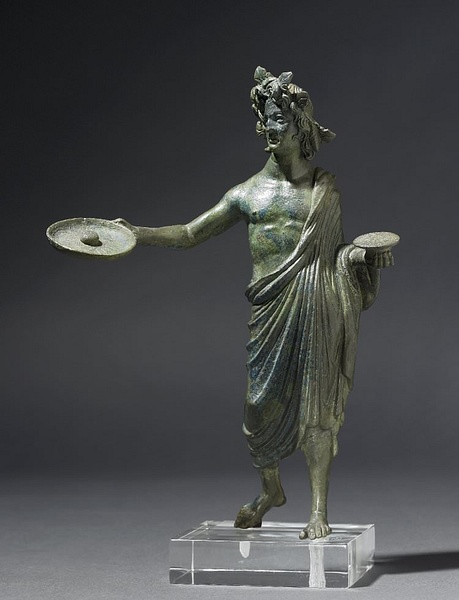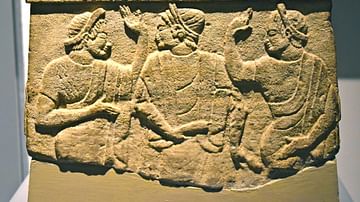The Etruscans produced bronze goods going back to the Villanovan period (1100-750 BCE) and used the material for all manner of objects, but it is their figure sculptures which have become some of the star attractions in museums worldwide. Bronze was a highly desirable material throughout antiquity and easily melted down for reuse so that it is even more remarkable that such fine works as the Chimera of Arezzo and Mars of Todi have survived to bear testimony today of the exquisite artistry of Italy's first great civilization.

Manufacture
Etruria was fortunate to have rich metal resources, especially copper, iron, lead, and silver. The early Etruscans put these to good use and bronze was used to manufacture a wide range of goods such as tools, weapons, armour, coinage, jewellery, hand fans, oil lamps, incense burners, mirrors, tripods, everyday dishes and utensils, cauldrons, horse bits, chests, and even chariots. Bronze was hammered, cut, cast using moulds or the lost-wax technique, embossed, engraved and riveted in a full range of techniques.
Beginning in the mid-8th century BCE, Etruscan artists benefitted from contact with Greek settlers (especially Euboeans) and traders from Phoenicia, Sardinia, Egypt, central Europe, and the Balkans. This brought technological refinements in metalwork and a whole new range of art ideas.
Many Etruscan towns set up workshops specialising in the production of bronze works and these included Acquarossa, Cerveteri, Chiusi, Populonia, Tarquinia, Vulci, Volsinii, and Volterra. To give an idea of the scale of production, the Romans were said to have looted more than 2,000 bronze statues when they attacked Volsinii (modern Orvieto) in 264 BCE, melting them down for coinage.
Figurines
Bronze figurines, often with a small stone base, were a common form of votive offering at sanctuaries and other sacred sites. Some, as with those found at the Fonte Veneziana of Arretium, were originally covered in gold leaf. An early figure is a 6th-century BCE hammered and cast bronze representation of a female goddess holding a bird from the Tomb of Isis at Vulci. It is 34 cm tall and originally had inlaid eyes and parts covered in gold foil. The figure is now in the British Museum London.
Most figurines are women in long chiton robes, naked males like the Greek kouroi, armed warriors and naked youths. Sometimes gods were presented, especially Hercules. A common pose of votive figurines is to have one arm raised (perhaps in appeal) and holding an object - commonly a pomegranate, flowers, or a circular item of food (probably a cake or cheese). Fine examples of smaller bronze works include a 6th-century BCE figurine of a man making a votive offering from the 'Tomb of the Bronze Statuette of the Offering Bearer' (Tomba del Bronzetto di Offerente) at Populonia. Another fine work is the 4th-century BCE statuette of two oxen and a ploughman from Arretium.

Volterra was noted for its production of distinctive bronze figurines which are extremely tall and slim human figures with tiny heads. They are perhaps a relic of much earlier figures cut from sheet bronze or carved from wood and are curiously reminiscent of modern art sculpture. The most famous example dates to the 3rd century BCE and is known as the Ombra della Sera ('Evening Shadow'). It is a 57 cm tall representation of a naked boy who is rigidly standing to attention and wearing the hint of a smile. The figure is on display in the Museo Etrusco Guarnacci in Volterra.
Realism over Aesthetics
Etruscan artworks were exported far and wide across the Mediterranean, and many have been discovered at sacred sites such as Olympia, Delphi and Dodona. Ancient writers such as Pliny the Elder praised the Etruscans for their bronze sculpture, in particular:
We see the Tuscan Apollo, in the library of the temple of Augustus, fifty feet in height from the toe; and it is a question whether it is more remarkable for the quality of the metal, or for the beauty of the workmanship. (Keller, 232)
The historian W. Keller explains what was unique about Etruscan bronze sculpture compared to works in other contemporary cultures:
It was not the Etruscan way to concentrate on externals, to aim at an unreal, idealized perfection of form. Their dynamic, vital works pulsed with life. Whether figures of animals or of human beings, they were not regular, balanced, or ideal. Etruscan artists aimed above all at bringing out the quintessence of their subject, its individual characteristics. They strove to express the inner driving force, the unconscious depths...Etruscan artists sought to grasp the personality of a man, its tough basic core, and to convey this realistically, regardless of aesthetics. It was their works that inspired the sober realistic art of the Roman portrait. (232-3)
Etruscan Masterpieces
Chimera of Arezzo
The Chimera is a fire-breathing monster from Greek mythology which has the head of a lion, tail of a snake and a goat's head protruding from its back. The sculpture, cast in bronze using the lost-wax technique, is 78.5 cm high and measures 129 cm in length. It dates to the 5th or 4th century BCE. The tail is the result of a restoration carried out in the 18th century CE based on a surviving fragment. It was probably part of a composition of pieces along with the hero Bellerophon, who killed the monster, and his winged horse Pegasus. There is an inscription on one leg which reads tinscvil or 'gift to Tin', indicating that it was a votive offering to the god Tin (aka Tinia), head of the Etruscan pantheon. Miraculously the sculpture was found in a ditch in 1553 CE when new fortifications were being raised at Arezzo by Cosimo de' Medici, the Grand Duke of Tuscany. It is currently on display in the Archaeological Museum of Florence.
Mars of Todi
Dating to the late 5th century or early 4th century BCE, the striking near life-size figure wears a cuirass and once held a lance. In the other hand he was probably pouring a libation. The figure is 142 cm tall and carries an inscription in Umbrian (ahal trutitis donum dede) which reveals it was dedicated by Ahal Trutitis, a Celt. It is thought to have been made in Arretium, even if it was discovered near Todi where it was ritually buried in a stone-lined trench after having been struck by lightning. It is now on display in the Vatican Museums in Rome.
Minerva of Arezzo
This representation of Menerva, the Etruscan goddess, who was the equivalent of the Greek goddess Athena and Roman deity Minerva, was made sometime between the 3rd and 1st century BCE. Discovered in 1541 CE in a well in Arezzo, it is currently on display in the Archaeological Museum of Florence.
Portrait of a Bearded Man 'Brutus'
This portrait head (mounted in a modern bust) has long been identified with Brutus, first consul of Rome, but there is no evidence for this association. Most art historians agree that on stylistic grounds it is an Etruscan work of around 300 BCE. It is now on display in the Capitoline Museums of Rome.
The Arringatore (Orator)
This life-size figure was made in the first half of the 1st century BCE and represents a standing male figure wearing a short-sleeved tunic and toga with his arm outstretched as if giving a speech. An inscription indicates it was offered in the name of one Aule Meteli (whom it may or may not represent). The statue was discovered near Lake Trasimene in 1566 CE, and it is currently on display in the Archaeological Museum of Florence.
Note: the statue known as the Capitoline She-wolf which is on display in the Capitoline Museums of Rome was long thought to be an Etruscan sculpture, but is now thought to belong to the 11th or 12th century CE.










